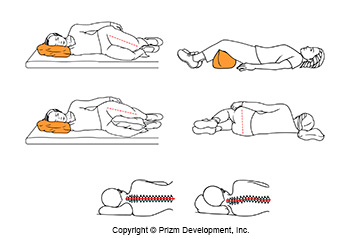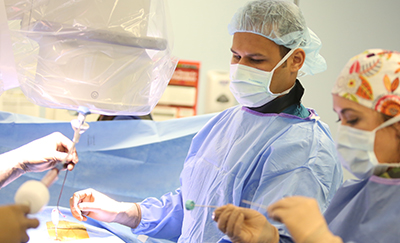 Preventing back and neck pain
Preventing back and neck pain
Once you encounter back or neck pain, you are four times as likely to experience it again. This is why prevention is essential to your long-term recovery.
One of the best ways to avoid back pain is by exercising and stretching. Low-impact aerobics, such as walking or swimming, is an ideal way to prevent or treat back pain. Stop if the exercise becomes painful, and always remember to stretch. Stretching is easy to incorporate into your daily routine. You can even do it in front of the television.
Below are some more specific ways to prevent back or neck injuries:

Sitting for long periods
The spine likes movement. Anything that puts the spine in a static position creates stress, which can cause back and neck pain. Every hour, stand, walk around, bend, arch backward gently and twist. Doing so at regular intervals will lengthen the amount of time you can sit comfortably. Also, get an ergonomically-designed chair or an orthopaedic insert to support your spine, especially if your job involves long periods of sitting. Or roll up a towel, and place it behind your low back.
A comfortable way to stand
Prolonged standing can also strain the back. If you have to stand for long periods of time, prop one foot on a small stool or telephone book to reduce stress in the low back. Alternate with the other foot. Every half hour, bend over and touch your toes, with your knees slightly bent or do some of the stretching exercises shown in this Web site. They will help loosen your muscles, ligaments and joints.
Plane rides
While traveling on a plane, it helps to raise your feet on a briefcase or a bag underneath the seat in front of you. Ask for a pillow to place behind your low back to improve lumbar support. It is important to get up frequently and walk to the bathroom and back, whenever possible. Avoid hour-long periods in your seat.
 The best sleeping position
The best sleeping position
Avoid sleeping on your stomach, which arches your back and puts pressure on your spine. Instead, lie on your back with a small pillow tucked under your knees. This position unloads the spine. An alternate position is to lie on your side with a pillow between your knees. If you like sleeping on your stomach, place a soft, flat pillow under your stomach to eliminate some of the arch that can stress your back.
Mattress considerations
It is important to sleep on a mattress with optimal back support, whether it is a conventional mattress or a waterbed. Older waterbeds were mushy and provided little support. However, now there are waterbeds that allow you to adjust their firmness. A good mattress should relate to your body shape. Generally, go with what feels comfortable to you.
When buying a new car
- Automatic transmission (reduces the use of foot pedals)
- Power steering (reduces the amount of effort to steer and turn the car)
- Car seat design – look for good lumbar support and a firm seat
Domestic chores
Avoid transporting heavy or large objects from one place to another after your surgery (eg. leaving ironing board in a suitable place rather than taking it in and out of a cupboard, arrange to have someone take out the rubbish). Also try to avoid heavy physical tasks (e.g. washing the car), particularly jobs that involve twisting and bending.
Relax
Relaxation is a useful tool for people with back pain (or anyone in general) for several reasons:
- It can prevent or alleviate aches and pains caused by excessive muscle tension.
- It can help minimize unnecessary fatigue and is useful in aiding recovery after strenuous exercise.
- It can raise the threshold for tolerance to pain.
The main aim of relaxation is to achieve a complete state of physical rest. Although this sounds easy, it is not something that comes naturally to us and must be learned and practiced. Talk to your medical team for more information.
[Top]
Maahir Haque, MD is recognized as a leader in the field of minimally invasive spine surgery. At Spine Group Orlando, Dr. Maahir Haque also provides second opinions for spine surgery and MRI reviews for those with back pain and neck pain. Dr. Haque emphasizes non-surgical options for back pain and neck pain where possible. This can include accessing a back pain specialist with expertise in pain-relieving spinal injections and spine therapists. Spine therapy can include back stretches that can be a future home remedy for back pain or neck pain. If spine surgery is necessary because of a herniated disc, spinal fracture, or spinal stenosis, Dr. Maahir Haque operates through tubular retractors that reduce the size of the incision, lessen blood loss, reduce time in the hospital, speed return to activity with a less painful recovery. This spine surgery expertise enables many patients to have outpatient spine surgery and be home the same day. Spine Group Orlando and Dr. Maahir Haque provides artificial disc replacement in the neck using the Mobi-C disc implant, the first FDA-approved disc for multiple levels in the neck. Prodisc-C is also used for artificial disc replacement in the cervical spine. Dr. Haque is also one of the few spine surgeons in Orlando, Florida to provide lumbar artificial disc replacement using the Prodisc-L artificial disc. Dr. Haque is also referred patients from across Orlando and north central Florida for artificial disc replacement surgery as an alternative to spinal fusion. Accordingly, Dr. Haque's patients travel from across north central Florida, including: Orlando; Jacksonville; Tallahassee; Lakeland; Gainesville; Tampa; Daytona Beach; and Cocoa Beach. The spine center, as a destination for medical tourism for some international patients from Mexico and the Caribbean, can provide recommendations to out-of-town patients on nearby hotels and tourist attractions. Dr. Haque is featured on the national site CentersforArtificialDisc.com as an author on the subject of artificial disc replacement for herniated discs in the neck. The Centers for Artificial Disc web site has content specific to disc replacement options and alternatives to spinal fusion. Click here to visit the Centers for Artificial Disc.







